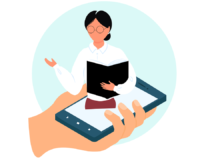
In physical classrooms, teachers circulate the room continuously to provide clarification of content to students. Struggling readers may receive guidance from an educator via small group or one on one instruction. An English learner may be paired with another student for native language translation. Special needs students may visit a resource specialist teacher for additional support. Psychologists and counselors may be available to provide support for emotional and behavioral needs.
At a distance, how do we ensure accessibility for these students?
Educators across the globe have pivoted their delivery of instruction, designing learning experiences that do not require physical presence in a classroom. This has been quite a feat, and I have been incredibly impressed by the way educators and leaders adapted to an unanticipated change in environment. This shift can be draining for educators, all are essentially first year teachers in a new mode of engaging students in learning. Educators who consider separate modifications to meet the varying needs of each special need learner may feel they are undertaking an arduous, time consuming task.
The key to accessibility is empowering those we serve. Rather than spending hours modifying learning experiences, educators can maximize their time and build the capacity of their students by introducing accommodations. This ensures students have the resources to access the same content as their peers. Click here to view the Universal Design for Learning (UDL) framework, based on neuroscience and created to assist educators in meeting the needs of ALL students in our midst.

UDL Supports Social-Emotional Growth
When we design learning experiences thoughtfully in accordance with the UDL framework, to account for variability, we honor student strengths. We break down barriers to grade level content. And we lessen anxiety and frustration. In the midst of a global pandemic and economic concerns, mental health organizations across the nation report an influx of requests for support. Students who experience trauma and/or stress often feel out of control. Fight against learned helplessness and empower your students to be resourceful students who own their learning. And watch self-confidence and self-efficacy build, tenets of SEL core competency self-awareness. And these tools will support students’ social emotional learning in the classroom as well!
Accessibility Resources
Immersive Reader – Microsoft has developed Immersive Reader, an excellent resource with numerous accessibility features. Immersive reader is built into OneNote Learning Tools. It also available via a third party chrome extension for browser use. If you use the collaborative video platform Flipgrid, immersive reader is embedded as well! Students can use immersive reader for text to speech with adjustable speed, translation, a picture dictionary to clarify vocabulary, syllabication, visual options, and identification of parts of speech. This proves beneficial for English Learners, struggling readers, and other special needs students. Click here to access a video teaching students how to use the immersive reader chrome extension.


Choice Boards – UDL calls upon educators to increase accessibility and empower students with multiple means of representation. When students are provided with options for accessing content, they learn the format that works best for them. This builds SEL competency self-awareness and leverages individual student strengths. Choice boards can be created with hyperlinks on a document or slidedeck. Options may include texts, images, videos, virtual reality tours, or step-by-step instructions for creating an experience at home. All options align to a common academic content goal. It is the method of representation that changes. Educators who utilize choice boards universally design a single resource for students, rather than spending the time to create several different lessons (modifications) to meet the variable learning needs of their learners.
YouTube – YouTube contains built-in accessibility features. These include closed captioning with translation options, as well as the ability to adjust playback speed. These features will work on the YouTube mobile app and also on videos viewed from YouTube.com on a browser. The accessibility settings are even available for YouTube videos embedded into Google Classroom, Google Sites, Google Forms, or Google Slides. Click here for tutorial that teaches students how to use YouTube accessibility features.

Sketchnotes & Booksnaps – Visuals are powerful. Students that struggle with vocabulary and written text greatly benefit from attaching content to the context of an image. While students are accessing content, encourage them to create sketchnotes, to include images as they document learning. As students read text, ask them to make inferences and read closely by inserting images to express their thoughts. Images strengthen connections in the brain to support memory during the learning process. The options of using visuals also support students’ emotional health, as some may feel more confident accessing content in images, and enjoy demonstrating learning in accordance with artistic strengths. Click here to view sketchnotes webinar with Sylvia Duckworth, author of several books about sketchnoting in education. Click here to view resources from Booksnaps founder Tara Martin.
As educators, we have the power to empower our learners to access content and express their understanding. Students that are empowered with choice, that feel they can be successful, grow in social-emotional development. Increase accessibility for your students. Encourage learners to be resourceful. And know that as students grow in independence outside of the classroom, it will benefit them when they return to campus as well.
